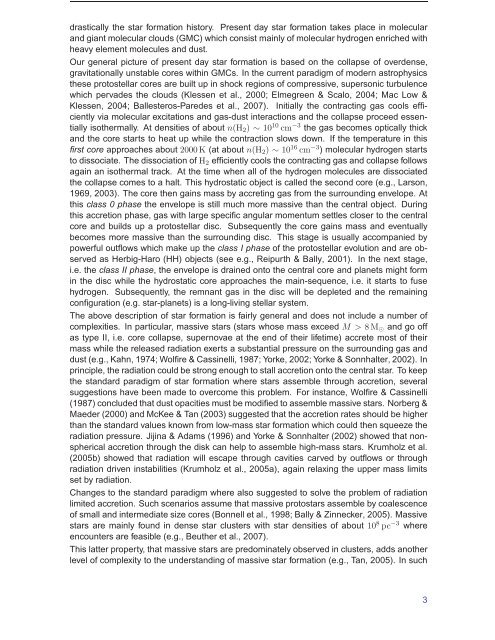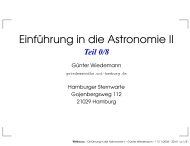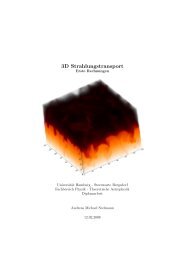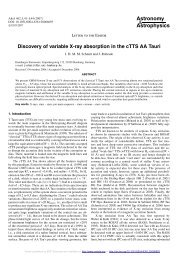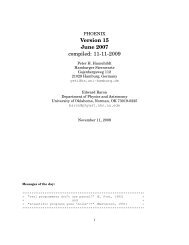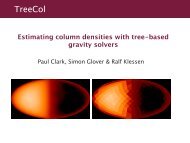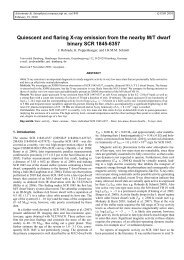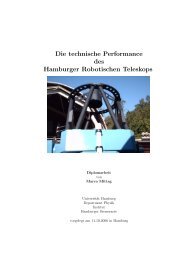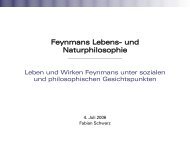Emmy Noether Application
Emmy Noether Application
Emmy Noether Application
You also want an ePaper? Increase the reach of your titles
YUMPU automatically turns print PDFs into web optimized ePapers that Google loves.
drastically the star formation history. Present day star formation takes place in molecular<br />
and giant molecular clouds (GMC) which consist mainly of molecular hydrogen enriched with<br />
heavy element molecules and dust.<br />
Our general picture of present day star formation is based on the collapse of overdense,<br />
gravitationally unstable cores within GMCs. In the current paradigm of modern astrophysics<br />
these protostellar cores are built up in shock regions of compressive, supersonic turbulence<br />
which pervades the clouds (Klessen et al., 2000; Elmegreen & Scalo, 2004; Mac Low &<br />
Klessen, 2004; Ballesteros-Paredes et al., 2007). Initially the contracting gas cools efficiently<br />
via molecular excitations and gas-dust interactions and the collapse proceed essentially<br />
isothermally. At densities of about n(H2) ∼ 10 10 cm −3 the gas becomes optically thick<br />
and the core starts to heat up while the contraction slows down. If the temperature in this<br />
first core approaches about 2000K (at about n(H2) ∼ 10 16 cm −3 ) molecular hydrogen starts<br />
to dissociate. The dissociation of H2 efficiently cools the contracting gas and collapse follows<br />
again an isothermal track. At the time when all of the hydrogen molecules are dissociated<br />
the collapse comes to a halt. This hydrostatic object is called the second core (e.g., Larson,<br />
1969, 2003). The core then gains mass by accreting gas from the surrounding envelope. At<br />
this class 0 phase the envelope is still much more massive than the central object. During<br />
this accretion phase, gas with large specific angular momentum settles closer to the central<br />
core and builds up a protostellar disc. Subsequently the core gains mass and eventually<br />
becomes more massive than the surrounding disc. This stage is usually accompanied by<br />
powerful outflows which make up the class I phase of the protostellar evolution and are observed<br />
as Herbig-Haro (HH) objects (see e.g., Reipurth & Bally, 2001). In the next stage,<br />
i.e. the class II phase, the envelope is drained onto the central core and planets might form<br />
in the disc while the hydrostatic core approaches the main-sequence, i.e. it starts to fuse<br />
hydrogen. Subsequently, the remnant gas in the disc will be depleted and the remaining<br />
configuration (e.g. star-planets) is a long-living stellar system.<br />
The above description of star formation is fairly general and does not include a number of<br />
complexities. In particular, massive stars (stars whose mass exceed M > 8M⊙ and go off<br />
as type II, i.e. core collapse, supernovae at the end of their lifetime) accrete most of their<br />
mass while the released radiation exerts a substantial pressure on the surrounding gas and<br />
dust (e.g., Kahn, 1974; Wolfire & Cassinelli, 1987; Yorke, 2002; Yorke & Sonnhalter, 2002). In<br />
principle, the radiation could be strong enough to stall accretion onto the central star. To keep<br />
the standard paradigm of star formation where stars assemble through accretion, several<br />
suggestions have been made to overcome this problem. For instance, Wolfire & Cassinelli<br />
(1987) concluded that dust opacities must be modified to assemble massive stars. Norberg &<br />
Maeder (2000) and McKee & Tan (2003) suggested that the accretion rates should be higher<br />
than the standard values known from low-mass star formation which could then squeeze the<br />
radiation pressure. Jijina & Adams (1996) and Yorke & Sonnhalter (2002) showed that nonspherical<br />
accretion through the disk can help to assemble high-mass stars. Krumholz et al.<br />
(2005b) showed that radiation will escape through cavities carved by outflows or through<br />
radiation driven instabilities (Krumholz et al., 2005a), again relaxing the upper mass limits<br />
set by radiation.<br />
Changes to the standard paradigm where also suggested to solve the problem of radiation<br />
limited accretion. Such scenarios assume that massive protostars assemble by coalescence<br />
of small and intermediate size cores (Bonnell et al., 1998; Bally & Zinnecker, 2005). Massive<br />
stars are mainly found in dense star clusters with star densities of about 10 8 pc −3 where<br />
encounters are feasible (e.g., Beuther et al., 2007).<br />
This latter property, that massive stars are predominately observed in clusters, adds another<br />
level of complexity to the understanding of massive star formation (e.g., Tan, 2005). In such<br />
3


